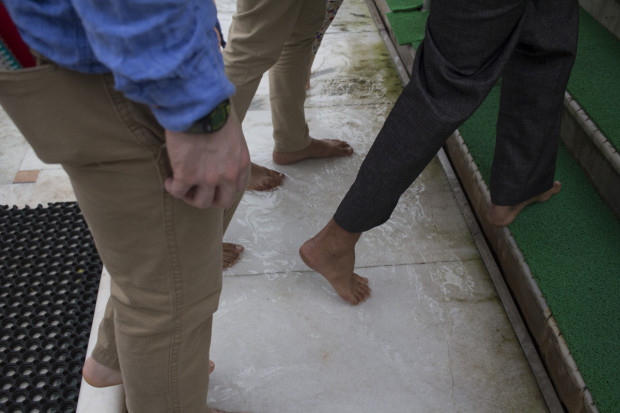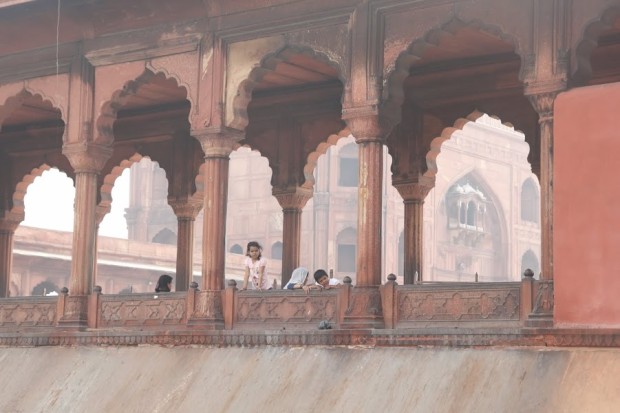NEW DELHI—Today, we discovered exactly why a class covering religion should travel to India. We saw first-hand how religion in India is not separate from any aspect of public life—especially political, social and cultural aspects.
We began our journey at the Red Fort, one of the first buildings built in the city, which was the office and residence of Mughal emperors. Here, we met our guide for the morning, Kanika Singh from Delhi Heritage Walks. Singh is a Ph.D. candidate at Ambedkar University in Delhi studying history in Sikh museums. As a more left-leaning Hindu woman, her opinions would prove to add insight to our discussions throughout the day. We walked across the street (no small feat with the numerous taxis and rickshaws that wouldn’t flinch at the possibility of hitting innocent visitors) to Chandni Chowk, one of the busiest markets in Delhi. We encountered the clash of the old and the new. Colonial-era buildings stood next to signs for electronics and one solitary neon sign for food. The middle of the street was being dug up while life continued to buzz around. Chandi Chowk means “Moonlit Square” because the street was originally a canal, with a large public tank of water known for reflecting moonlight.
The end of the street is marked by two temples, one Jain and one Hindu. In India, it is not uncommon to see houses of worship sharing street space. Just down the road we encountered a Baptist Church and a Sikh Gurudwara, Sis Ganj Sahib, which we had the opportunity to enter and experience. Around the corner, down a tiny side alley, we visited a Hindu temple, smaller than the others we had seen, and attached to a personal residence. I was struck by the prominence of religious spaces in addition to the diversity of faiths we saw. The grandeur of the temples and church were set against a backdrop of tiny shops tucked into crowded corridors, further emphasizing the prominence of sacred spaces.

Visitors are asked to take off their shoes and cleanse their feet with water before entering the Sis Ganj Sikh Gurdwara. Photo by Han Zhang.
Next, we walked to the Jama Masjid, the largest mosque in India, to meet with Imam Syed Bukhari. We were given the opportunity to ask questions on several aspects of religion and public life. We opted to inquire about everything from the recent controversy over the ban of beef in one region of India, (since cows are holy to Hindus, this is a point of contention between Hindus and Muslims) to Islamic extremism. We soon realized that our American ideas surrounding the separation of church and state did not apply. Bukhari informed us that in India, religion and politics are inextricable. As a result, an Imam has the duty to guide his community on every aspect of life, including who to vote for and how to interact with other religious communities.
After the conversation with Bukhari, we sat on the steps of the Jama Masjid and had a frank discussion about what he had told us. While we disagreed with some of his somewhat conservative opinions, we reveled in the freedom to sit outside and have such an honest chat, appreciating the pluralistic spirit of India. Our busy morning made us hungry, so for lunch we had parathas, pan-fried Indian flat breads. Being from Wisconsin, I of course had one filled with cheese. They were fresh and came to our tables absolutely steaming!
We proceeded to the Indo-Tibetan community in Delhi, where the Media Coordinator for the Bureau of his Holiness the Dalai Lama, Tenzin Lekshay, spoke to us about the community that had formed in Delhi after being exiled from Tibet. He shared his opinion on India’s political and moral responsibility to help the Tibetan community since the Tibetans had worked to preserve Buddhism, a religion which had almost been forgotten in India. He said that the Tibetans carried the scriptures on their backs when fleeing their homeland; currently, many of those Buddhist texts are being translated back from Tibetan into Sanskrit in India.
Finally, we visited Parliament to meet with Tarun Vijay, a writer and a BJP Member of Parliament of the Rajya Sabha, or the Upper House. Before meeting him, as we walked through the parliament building, I noticed a painting of the Buddha sitting under the Bodhi tree. I was struck that the Indian origins of Buddhism were so prominently acknowledged in such a significant government space, despite Buddhists being a small minority in India.
Vijay’s opinions contrasted greatly with the Imam we had met with only a few hours before, and it was fascinating to see their differences of opinion play out so clearly in front of us. Vijay admitted he felt that India’s “pluralism on the ground is the best example of coexistence in the world today,” a sentiment that harkened back to the morning’s experience of witnessing so many faiths residing within close proximity of one another. Many of the students were tired after the long day, but were rejuvenated when Vijay’s staff served scrumptious sweets and aromatic chai.
Vijay’s opinions obviously reflected his Hindutva ideology and the beliefs of his party, as he ardently argued that the conversion of Hindus to Christianity and Islam was a kind of political weapon. Once again, we were able to debrief afterwards, discussing the polar opposite opinions we had encountered in the course of just one day. The day’s lesson was clear: India is an exemplary case of religious pluralism, diversity, and even polarization. It had been a long day, but one we would remember throughout our careers as journalists. After all, it is not every day that one has tea at the Parliament.
